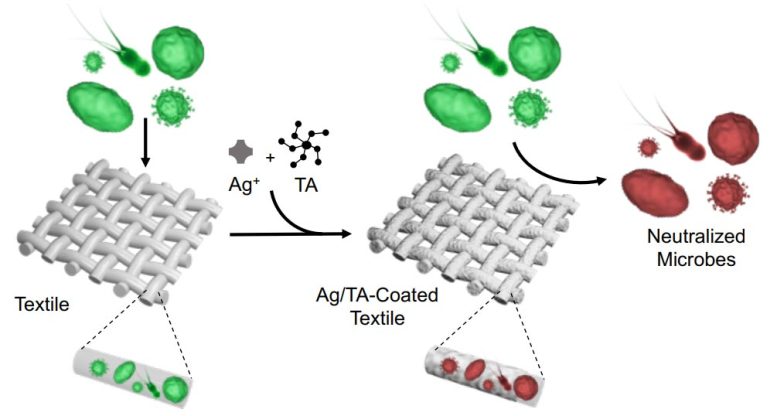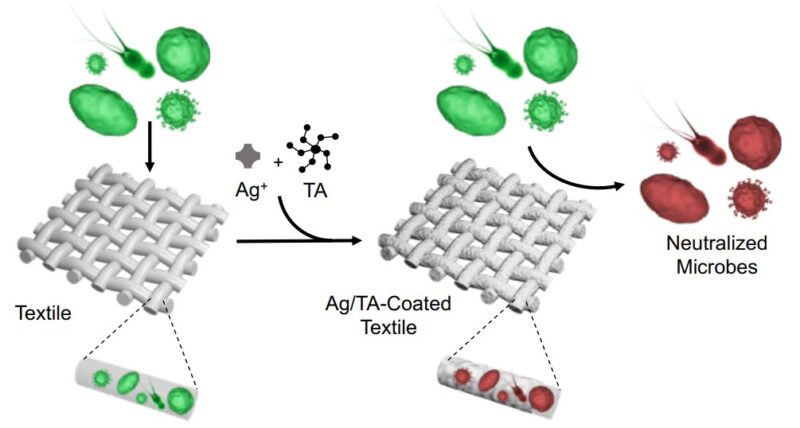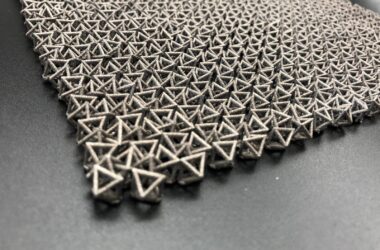
Malgré leur capacité à neutraliser les agents pathogènes, les polyphénols et l’argent sont considérés comme extrêmement sûrs. Les polyphénols sont présents dans de nombreux types d’aliments consommés quotidiennement, et l’argent n’interagit pas avec le corps humain. L’enrobage Ag/TA pourrait donc être réalisé par n’importe qui, et pas seulement dans des environnements industriels étroitement contrôlés. Crédit : 2022 Ejima et al.
L’argent et les produits chimiques présents dans le vin et le chocolat sont utilisés pour créer un revêtement textile antimicrobien.
Pour la première fois, des chercheurs ont trouvé un moyen rentable et pratique d’appliquer un revêtement transparent antimicrobien à base d’argent sur des textiles neufs ou existants. Leur méthode utilise des polyphénols, que l’on trouve couramment dans des aliments connus pour tacher les vêtements, comme le vin et le chocolat. La méthode des chercheurs permet de traiter toute une série de types de textiles et les articles peuvent être lavés plusieurs fois sans perdre leur propriété antimicrobienne et donc anti-odeur.
C’est peut-être l’hiver pour la moitié du monde en ce moment, mais d’ici peu, le temps chaud reviendra, apportant avec lui les sorties à la plage, les glaces, les piqûres d’insectes et, bien sûr, la sueur. Il existe de nombreux types de produits à porter ou à appliquer sur le corps qui visent à réduire les odeurs corporelles, mais ils s’accompagnent souvent d’un compromis tel que le coût, la respirabilité, le choix limité, ou autre. Certains de ces produits utilisent l’argent, bien connu pour ses propriétés antimicrobiennes, mais il peut être difficile de l’appliquer sur des objets tels que les vêtements de manière simple et efficace.
Une équipe dirigée par des chercheurs de la Graduate School of Engineering de l’Université de Tokyo a mis au point une méthode d’application d’un revêtement d’argent antimicrobien sur les textiles qui est rentable, simple et qui a également des implications utiles. Ils ont essentiellement utilisé un composé appelé polyphénol, le tannique acid (TA) specifically, to bind silver (Ag) to fabrics. Polyphenols are found in chocolate and red wine amongst other things, and are responsible for their infamous ability to stain clothing and tablecloths. Fortunately, the researchers’ coating, called Ag/TA, is completely clear so it doesn’t discolor textiles, but best of all, it can survive being washed.
“As kids often do, my son stained his shirt with chocolate one day, and I couldn’t scrub it out,” said postdoctoral fellow Joseph Richardson. “Associate Professor Hirotaka Ejima and I have studied polyphenols for over a decade, but this chocolate incident got me thinking about using tannic acid to bind silver to fabrics. We think we’ve found two methods to apply our antimicrobial silver coating to textiles, suitable for different use cases.”
The first method might be useful for commercial clothing or fabric producers. Textiles can simply be bathed in a mixture of the silver compound and the polyphenol binder. Another method, perhaps more suited to small-scale settings, including the home, is to spray items of clothing, first with the silver compound and then with the polyphenol binder. An obvious advantage is that people can add the coating to existing items of clothing.
“But what’s most exciting is not the ease of application, but how effective the coating is,” said Richardson. “We wanted to study the effect of the antimicrobial coating not just on odor-causing bacteria, but also on fungi and pathogens like viruses. With so many variables to control, it was a challenge of time and complexity to test variations of compounds against variations of microorganisms. But through carefully optimizing our testing methods, we found that the coating neutralizes everything we tested it on. So Ag/TA could be useful in hospitals and other ideally sterile environments.”
The binding power of TA is so strong that coated textiles tested by the researchers like cotton, polyester, and even silk, maintain antimicrobial and anti-odor properties for at least 10 washes.
“This isn’t just a hypothetical situation limited to the lab, I’ve tried it on my own shirts, socks, shoes, even my bathmat,” said Richardson. “We’d like to see what other useful compounds polyphenols might help bind to fabrics. Antimicrobial silver might just be the start.”
Reference: “Rapid Assembly of Colorless Antimicrobial and Anti-Odor Coatings from Polyphenols and Silver” by Joseph J. Richardson, Wenting Liao, Jincai Li, Bohan Cheng, Chenyu Wang, Taku Maruyama, Blaise L. Tardy, Junling Guo, Lingyun Zhao, Wanping Aw and Hirotaka Ejima, 8 February 2022, Scientific Reports.
DOI: 10.1038/s41598-022-05553-9



